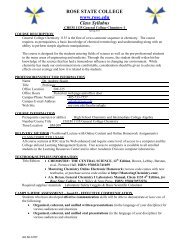Chapter 4
Chapter 4
Chapter 4
Create successful ePaper yourself
Turn your PDF publications into a flip-book with our unique Google optimized e-Paper software.
4-1
<strong>Chapter</strong><br />
4<br />
Planning and Strategic Management<br />
McGraw-Hill/Irwin<br />
Management, 7/e<br />
Copyright © 2007 The McGraw-Hill Companies, Inc. All rights reserved.
4-3<br />
Learning Objectives<br />
After studying <strong>Chapter</strong> 4, you will know:<br />
How to proceed through the basic steps in any planning<br />
process<br />
How strategic planning integrates with tactical and<br />
operational planning<br />
Why I is important to analyze both the external<br />
environment and the internal resources of the firm before<br />
formulation a strategy<br />
The choices available for corporate strategy<br />
How companies can achieve competitive advantage<br />
through business strategy<br />
How core competencies provide the foundation for<br />
business strategy<br />
The keys to effective strategy implementation
4-4<br />
Overview of Planning Fundamentals<br />
Planning is the conscious, systematic process of<br />
making decisions about goals and activities that an<br />
individual, group, work unit, or organization will<br />
pursue in the future<br />
Planning is a purposeful effort that is directed and<br />
controlled by managers and often draws on the<br />
knowledge and experience of employees throughout<br />
the organization<br />
Planning provides individuals and work units with a<br />
clear map to follow in their future activities
4-5<br />
The Basic Planning Process<br />
Planning is a decision process (you’re<br />
deciding what to do and how to go about<br />
doing it)<br />
Steps in the planning process are is similar to<br />
the decision making process<br />
Planning is a cyclical process because plans<br />
are evaluated and revised if necessary
Comparing Decision Making and Planning<br />
4-6
4-7<br />
The Basic Planning Process<br />
The basic planning process includes the<br />
following<br />
Situational Analysis<br />
Alternative Goals and Plans<br />
Goal and Plan Evaluation<br />
Goal and Plan Selection<br />
Implementation<br />
Monitor and Control
4-8<br />
Levels of Planning<br />
Strategic Planning<br />
Tactical Planning<br />
Operational Planning
Levels of Planning<br />
4-9
4-10<br />
Strategic Planning: Defined<br />
A set of procedures for making decisions<br />
about the organization’s long-term goals and<br />
strategies<br />
Strategic goals are major targets or end<br />
results relating to the organization’s longterm<br />
survival, value, and growth<br />
Strategy is a pattern of actions and resource<br />
allocations designed to achieve the<br />
organization’s goals
4-11<br />
Strategic Planning<br />
How does one of the<br />
world’s most respected<br />
news sources, The New<br />
York Times, continue to<br />
succeed after a year<br />
(2004) of journalistic<br />
scandal, a quick-as<br />
lightening and dynamic<br />
media world, and<br />
weak earnings?
4-12<br />
Tactical and Operational Planning<br />
Tactical Plans are a set of procedures for<br />
translating broad strategic goals and plans<br />
into specific goals and plans that are relevant<br />
to a distinct portion of the organization, such<br />
as a functional area like marketing<br />
Operational Planning is the process of<br />
identifying the specific procedures and<br />
processes required at lower levels of the<br />
organization.
Aligning Tactical, Operational, and<br />
Strategic Planning<br />
4-13<br />
To be fully effective, the organization’s<br />
strategic, tactical, and operational goals and<br />
plans must be aligned<br />
Consistent<br />
Mutually supportive<br />
Focused on achieving the common purpose<br />
and direction
Strategic Map<br />
4-14
4-15<br />
Strategic Planning<br />
Historically strategic planning emphasized a<br />
top-down approach—senior executives and<br />
specialized planning units developed goals<br />
and plans for the entire organization<br />
Today senior executives increasingly are<br />
involving managers throughout the<br />
organization in the strategy formation<br />
process
4-16<br />
Strategic Planning<br />
Strategic management is the new term that<br />
has emerged for the strategic planning<br />
process<br />
Strategic Management is a process that<br />
involves managers from all parts of the<br />
organization in the formulation and<br />
implementation of strategic goals and<br />
strategies
Strategic Management Process<br />
4-17
4-18<br />
Strategic Management: Step 1<br />
Establishment of mission, vision, and goals<br />
Mission is an organization’s basic purpose and<br />
scope of operations<br />
Strategic vision is the long-term direction and<br />
strategic intent of a company<br />
Strategic goals evolve from the mission and<br />
vision of the organization
4-19<br />
Strategic Management: Step 2<br />
Analysis of External Opportunities and<br />
Threats<br />
Successful strategic management depends on<br />
an accurate and thorough evaluation of the<br />
environment<br />
Begins with an examination of the industry<br />
Stakeholders are examined next<br />
Managers should also examine other forces in<br />
the environment, such as macroeconomic<br />
conditions and technological factors<br />
One critical task is forecasting future trends
Analysis of External Opportunities and<br />
Threats<br />
4-20
4-21<br />
Strategic Management: Step 3<br />
Analysis of Internal Strengths and Weaknesses<br />
This kind of internal analysis provides strategic<br />
decision makers with an inventory of the<br />
organization’s existing functions, skills, and<br />
resources as well as its overall performance level<br />
This step will also include looking at the firms<br />
resources and core competencies<br />
A final area may include benchmarking with other<br />
firms
Analysis of Strengths and Weaknesses<br />
4-22
Strategic Management: Step 3<br />
4-23
4-24<br />
Strategic Management: Step 4<br />
SWOT Analysis and Strategy Formulation<br />
By completing steps 2 and 3 managers will be<br />
able to analyze the companies strengths,<br />
weaknesses, opportunities and threats (SWOT)<br />
Once the SWOT has been completed<br />
management will be able to begin to formulate<br />
a strategy
4-25<br />
Corporate Strategy<br />
Corporate Strategy The set of businesses, markets, or<br />
industries in which an organization competes and the<br />
distribution of resources among those entities<br />
Concentration A strategy employed for an organization<br />
that operates a single business and competes in a<br />
single industry<br />
Concentric Diversification A strategy used to add new<br />
businesses that produce related products or are<br />
involved in related markets and activities<br />
Vertical Integration The acquisition or development of<br />
new businesses that produce parts or components of<br />
the organization’s product
Summary of Corporate Strategies<br />
4-26
Boston Consulting Group<br />
4-27
4-28<br />
Business Strategy<br />
Business Strategy is the major actions by which a<br />
business competes in a particular industry or market.<br />
Low-Cost Strategy is a strategy that an organization<br />
uses to build competitive advantage by being efficient<br />
and offering a standard, no frills product.<br />
Differentiation Strategy is a strategy that an<br />
organization uses to build competitive advantage by<br />
being unique in its industry or market segment along<br />
one or more dimensions.<br />
Functional Strategies are strategies implemented by<br />
each functional area of the organization to support the<br />
organization’s business strategy.
Strategic Management: Step 5<br />
Implementation<br />
4-29<br />
There are two major trends related to<br />
implementation<br />
Organizations are adopting a more comprehensive<br />
view of implementation<br />
Managers at all levels of the organization are being<br />
involved with the implementation process<br />
Implementation generally involves four related<br />
steps<br />
Define strategic tasks<br />
Assess organization capabilities<br />
Develop an implementation agenda<br />
Create an implementation plan
Barriers to Implementation<br />
4-30
4-31<br />
Strategic Management: Step 6<br />
Strategic Control<br />
A system designed to support managers in<br />
evaluating the organization’s progress regarding its<br />
strategy and, when discrepancies exist, taking<br />
corrective action<br />
The organization must develop performance<br />
indicators, an information system, and specific<br />
mechanisms to monitor progress<br />
Normally includes a budget
4-32<br />
Looking Ahead<br />
<strong>Chapter</strong> 5 Ethics and Corporate Responsibility<br />
How different ethical perspective s guide decision<br />
making<br />
How companies influence the ethics environment<br />
A process for making ethical decisions<br />
The important issues surrounding corporate social<br />
responsibility<br />
The importance to business of our natural<br />
environment<br />
Action managers can take to manage with the<br />
environment in mind
4-33<br />
Situational Analysis<br />
A process planners use, within time and<br />
resource constraints, to gather, interpret, and<br />
summarize all information relevant to the<br />
planning issue under consideration<br />
Return
4-34<br />
Alternative Goals and Plans<br />
Based on the situational analysis, the<br />
planning process should generate alternative<br />
goals that may be pursued in the future and<br />
the alternative plans that may be used to<br />
achieve those goals<br />
Goals are a target or end that management<br />
desires to reach<br />
Plans are the actions or means managers<br />
intend to use to achieve organizational goals<br />
Return
4-35<br />
Goal and Plan Evaluation<br />
This step is made up of<br />
two activities<br />
Managers will evaluate<br />
the advantages,<br />
disadvantages, and<br />
potential effects of each<br />
alternative goal and<br />
plan.<br />
They will prioritize those<br />
goals and even eliminate<br />
some of them from<br />
consideration.<br />
Return
4-36<br />
Goal and Plan Selection<br />
Managers will select the goal and plan that is most<br />
appropriate and feasible once they have assessed all of<br />
the various goals and plans<br />
Some organizations will generate planning scenarios to<br />
aid in the evaluation and selection process<br />
Scenario – a narrative that describes a particular set of<br />
future conditions<br />
This approach helps the firm avoid crises and allows<br />
greater flexibility and responsiveness<br />
Return
4-37<br />
Implementation<br />
Managers and employees must:<br />
Understand the plan<br />
Have the resources necessary to implement<br />
the plan<br />
Be motivated to implement the plan<br />
The implementation phase probably will be<br />
more effective and efficient If both managers<br />
and employees have participated in the<br />
planning process<br />
Return
4-38<br />
Monitor and Control<br />
This step is essential in a formal planning<br />
process<br />
Managers will need to develop control<br />
systems that measure thee plan’s<br />
performance<br />
Managers should take corrective action when<br />
the plans implemented improperly or when<br />
the situation changes<br />
Return
4-39<br />
Stakeholders<br />
Groups and individuals who affect and are<br />
affected by the achievement of the<br />
organization’s mission, goals, and strategies.<br />
Return
4-40<br />
Resources and Core Competencies<br />
Resources are inputs to a system that can enhance<br />
performance<br />
Tangible assets such as real estate, production facilities,<br />
raw materials and so on<br />
Intangible assets such as company reputation, culture,<br />
technical knowledge, patents, and accumulated learning<br />
and experience<br />
Resources can create a competitive advantage if:<br />
They are instrumental for creating customer value<br />
They are rare and not equally available to all<br />
competitors<br />
They are difficult to imitate<br />
Finally they must be well organized<br />
Return
4-41<br />
Core Competencies<br />
Core competencies are the unique skills<br />
and/or knowledge an organization possesses<br />
that give it an edge over competitors.<br />
Generally it refers to a set of skills or<br />
expertise in some activity, rather than<br />
physical or financial assets.<br />
Return

















